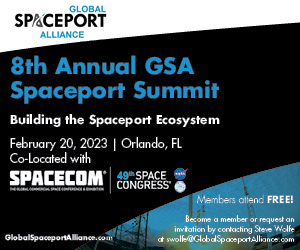A global network of spaceports will enable the roll-out of point-to-point transportation for cargo followed by other payloads including potentially humans in the near future, according to Dr George C Nield, Chairman of the Global Spaceport Alliance.
Speaking to FINN, Nield said that whether it was for exploration, research, or just travelling the world to see the sights or visit relatives, the use of a high-speed civilian transportation system in space was “going to happen much faster than people are expecting”.
“These next couple of years are going to be very busy,” Nield said, but added: “It is possible that they might need a little more time to demonstrate system safety and reliability before the rest of us are ready to take a ride.”
The Global Spaceport Alliance (GSA) was established in 2015 with the goal of creating a global network of spaceports that will allow increased access to space, and that can serve as focal points and technology hubs in growing the space economy.
The group currently has 26 Member Spaceports from nine different countries, plus 15 Associate Members, and 11 Government, Academic, or Nonprofit organisations.
GSA holds an annual Spaceport Summit in Orlando in conjunction with the SpaceCom Conference, and it is actively involved in partnering with stakeholders in government, industry, and academia.
Spaceports
Commenting on the proliferation of spaceports and associated space launch projects, Nield said: ”There are currently a wide range of different vehicles under development, and they have a lot of different capabilities. They’re different sizes, different speeds, and are being designed for different missions.
“One vehicle to watch is at SpaceX, where they are developing a system they call Starship, that is sitting on the launch pad right now. That is an amazing vehicle. It is very large, it has an interior volume greater than an Airbus 380, and it is capable of lifting 100 metric tonnes all the way to orbit.
“That same system has the capability to fly from one point on the Earth to any other point in less than an hour, and it could carry 100 or 200 people, depending on how it’s configured. We may start seeing test flights happen right away. NASA has already contracted with SpaceX to land astronauts on the moon in 2025 using the Starship.”
Use cases
When it comes to the spaceports themselves, not all are the same – “and they really don’t need to be”, said Nield. “In fact, I think having a network of spaceports with different capabilities can be very beneficial.”
The GSA chairman sees two primary use cases that are going to help the aerospace community take advantage of new technologies and innovation.
“First would be assured access to space – and to do that, it will be important that we not just have one or two places where we launch all of our rockets,” he said.
“We need to acknowledge that there could be hurricanes, tornadoes, wildfires, earthquakes or launchpad accidents that could significantly damage one of those sites and thereby prevent them from operating for many months or even years at a time.
“It will be important that we have a number of sites that we can launch from that will allow us to have rapid and responsive access to space, and that’s something we really have not had to this point.
“The second use case is point-to-point transportation through space. I believe that the ability to fly from one point on the Earth to the opposite side of the planet in just an hour or two, first with cargo, but eventually with people, is really going to be a game changer in terms of how we travel, how we communicate, and how we do business.”
Collaboration
Much of the work being done hinges on collaboration between both public and private sectors.
Nield explained: “Historically space has had three different sectors: the civil sector (which includes organisations like NASA and other government agencies), the commercial sector (which is industry), and the national security space sector.
“They used to be very much separate and independent from one another. But now we’re seeing a lot more cooperation and collaboration. As a result, what happens in one sector can benefit the other sectors. We’re starting to see that for rockets and spacecraft, where it’s no longer the government being the first to develop new systems and then industry following along several years later, which is what we used to see in aviation.
“Now we’re seeing industry leading the way in a number of different areas – reusable launch systems, autonomous flight safety systems, mega constellations of small satellites. I think that we can follow the same process for spaceports, with federal launch sites, commercial sites, and privately owned and operated sites all working together and collaborating to contribute to a modern, robust, resilient and very capable spaceport network that can benefit the entire world.”
Challenges
But a number of challenges remain. “Propulsion systems, strong and lightweight materials, and thermal protection systems have long been among the technical challenges of designing systems to fly to space. But after 60 years of human spaceflight, we’ve learned a lot,” Nield concluded.
“And so perhaps the most important challenges right now are the regulatory challenges, updating our policies and procedures to ensure that systems which fly much higher and much faster than existing aviation systems can be allowed to safely operate along with aircraft, drones, balloons and other users of the airspace.
“We’re also going to need to understand and do all we can to minimise any potential impact on the environment in terms of noise and emissions. But I feel pretty confident that we are going to be able to do that and to continue to make rapid progress in the years ahead.”
Subscribe to the FINN weekly newsletter


